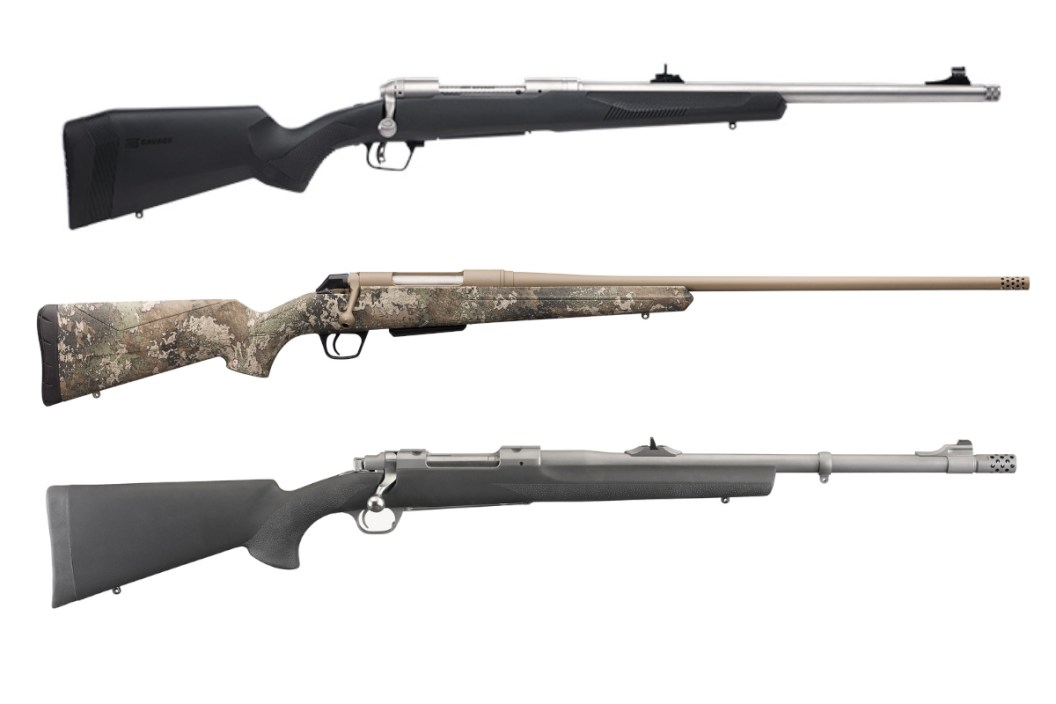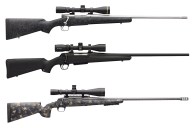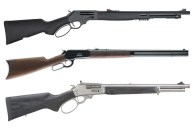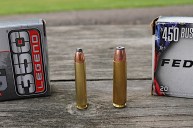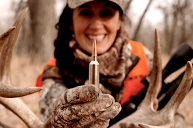The 338 Winchester Magnum is a great elk hunting cartridge.
When you're hunting some of the larger big game animals of North America like brown bear and elk, you'll need a powerful rifle cartridge. There's a ton of options out there, but the 338 Winchester Magnum is one of the most versatile because it can handle larger, heavier bullets, and cause an incredible amount of damage, leading to more recoveries.
As a round, the 338 Win Mag has long proven a favorite of Alaskan guides who want a ton of stopping power to protect their clients in case of a bear attack. In addition to the dangerous game of America, the round has also proven extremely popular in Africa for many plains animals.
Let's check out this interesting rifle cartridge, its origins, and why it just may be the best elk hunting centerfire cartridge on the planet today.
338 Winchester Magnum, A Brief History
This is one of those rounds that's been around forever, has a plethora of bolt action rifles chambered for it, and yet somehow still manages to fly under the radar. This cartridge was born of a monster, the .375 H&H Magnum, which was the parent case. As the name implies, this round has a bullet diameter of .338 inches. The case is shortened slightly and blown out from the original configuration of the .375.
If you really start diving into it, you'll find notable names like Elmer Keith were involved in the development of this round. He was best known for his work developing the iconic .357 Magnum and .44 Magnum, but he was also a wildcatter. Along with Don Hopkins and Charlie O'Neil, Keith started experimenting with 33 caliber bullets, which were popular in Europe at the time. They ended up developing the .333 and .334 OKH cartridges, which were named for their initials. In any case, those rounds were developed from the .30-06 Springfield.
From there, they eventually developed the 338, which came out in 1958. According to American Rifleman, at the time, it was only available in one gun, the Winchester Model 70 Alaskan. However, the round proved popular, and it didn't take long for other companies to soon come around. Today, almost every major manufacturer offers at least one 338 Winchester Magnum firearm in their modern lineups.
Ballistics of the 338 Winchester Magnum
One of the reasons the .338 Winchester Magnum cartridges took off was simply because back in 1958, most hunters were looking to use heavy, hard-hitting bullets to down game quickly.
We should take a moment to talk about the .300 Winchester Magnum. It's impossible to address the 338 without mentioning the 300, because when you start diving into the numbers, the two rifle cartridges are nearly identical in terms of speed and foot pounds of energy delivered to the target. We won't get too much into the specifics, because YouTuber Ron Spomer does a good job of that in the video above if you're curious. It basically boils down to the 300 having a better ballistic coefficient and higher muzzle velocity, give or take about 100 fps depending on the ammo. The reason you might want to pick the 338 over the 300 is because the 338 has a better sectional density. This means the bullets are a slightly larger diameter and they're going to hit with a little more energy.
In 1958, the ability to use slightly heavier bullet weights up to 250 grains proved popular with shooters. It still does today. There are even some shooters who have stepped things up to 300-grain bullets with the 338. Obviously, this robs the round of some long-range capabilities, but this round has never really been about reaching out past 300 or 400 yards anyway. The 338 has always been about knockdown power, especially on elk.
Hearing those bullet weights, you're probably thinking the 338 has some kick, and you'd be correct. Although it is usually considered a little more moderate than some of the other 33 caliber options on the market today, like the 338 Lapua. Still, you'll find most experts recommend a slightly heavier rifle to help soak up some of the kick from this gun.
Let's look at the numbers for some factory ammo. Nosler offers several variants of their Accubond Trophy Grade ammo. The polymer tip, 225-grain Spitzer bullets have a muzzle velocity of 2,750 fps and are doing about 2,585 fps at 100 yards. You're looking at about 3,300-foot pounds of energy at 100 yards with these bullets. Step it up to 250 grains and you can expect 2,650 at the muzzle, 2,496 fps at 100 yards. Meanwhile the 250-grain Nosler Partition bullets are doing 2,600 fps at the muzzle and 2,415 fps at 100 yards while putting out 3,238-foot pounds of energy.
Remington makes some 338 Win Mags in their popular expanding Core-Lokt line of ammo. Expect 2,780 fps at the muzzle, and 2,572 fps at 100 yards. The 250-grain bullets are doing about 2,660 fps at the muzzle and 2,456 at 100 yards. When these big bullets strike an elk, they put a hurting on the animal. If there is one downside to the 338, it's that the factory rifle ammunition is usually quite expensive. Which is another reason this is a popular round for reloading.
You can probably expect to get a little more velocity out of handloads using popular bullets from the usual brands like Barnes TSX or Hornady SST or EDL-X. Now let's look at some of the rifles on the market today that are perfect for North American big game.
Winchester XPR
It's only fitting to start this list with the company responsible for introducing the round to the world. The XPR is one of the newer additions to the Winchester line and it has proven extremely popular so far. They offer a few different variants, including one with a Turkish walnut stock. They all come in around the seven-pound mark. Winchester offers the rifle with either a 24- or 26-inch barrel with a 1:10 twist rate. Finishes vary from a classic matte blue to Permacote flat dark earth. These rifles are purposely built to be tough for the elements of the backcountry, whether that be the high deserts of Wyoming or the mountains of Alaska.
Ruger Hawkeye Alaskan
This one is popular with the big game guides in the Last Frontier as a backup for their clients, and in case of an unwanted bear that just won't go away. This rifle features a 20-inch, cold hammer forged, stainless steel barrel with a 1:9 rate of twist and a radial-port muzzle brake. The more compact 42-inch length is going to make it an ideal brush gun. The eight-pound weight will help to mitigate some of that recoil. Ruger gave this gun a generous recoil pad on the Hogue OverMolded stock to help in that regard, too. This is also going to be a reliably cycling rifle thanks to the Mauser-type extractor. This rifle is built for the rigors of Alaska, which means it'll work for just about any North American hunt for large game.
Benelli R1
When we're talking about large, heavy rounds for animals like elk, we usually do not think semi-automatic. Benelli has built a fascinating rifle here with the R1, which cycles off a gas-operated system they call ARGO, (for auto-regulating gas-operated). This will allow you to get follow-ups on an animal faster than ever before, and if you're being charged by a bear, no worries about putting a second or third round in the bruin. This rifle has a 24-inch barrel with a 1:10 rate of twist. It comes in at 7.3 pounds. Benelli offers this rifle in either a black synthetic or with a nice-looking AA-grade walnut.
Savage Arms 110 Brush Hunter
The Savage 110 Brush Hunter is another compact option that's great for anyone who spends a lot of time in the backcountry and wants a gun that can both down big game and protect from an unwanted bear encounter. This rifle features a 20-inch barrel with a 1:10 twist. The overall length is right at 41 inches, and it weighs 7.38 pounds. This firearm features Savage's signature AccuTrigger system, allowing you to adjust the trigger pull yourself, no trip to the gunsmith required. Savage also made the length of pull adjustable using just a few screws so you can perfectly adjust the rifle to fit your frame and body type.
Mossberg Patriot Cerakote
The Mossberg is a great option for a newer elk hunter, or simply someone on a budget who wants a rifle that can handle every type of big game animal in North America. Mossberg offers a few different variants that cost less than this, but you're going to be hard pressed to find another rifle with a Cerakote finish for under $600 like the Patriot. This rifle has a 24-inch barrel with a 1:10 twist rate. The barrel is also sent threaded from the factory. It is a lot lighter than any other gun on this list at 6.5 pounds. It's going to be easier to carry deep into the backcountry, but it's going to have a lot more kick.
For more outdoor content from Travis Smola, be sure to follow him on Twitter and Instagram For original videos, check out his Geocaching and Outdoors with Travis YouTube channels.
READ MORE: 28 NOSLER: THE ROUND THAT CAN HARVEST BUCKS, BEARS, AND BULLS AND 5 RIFLES CHAMBERED FOR IT
